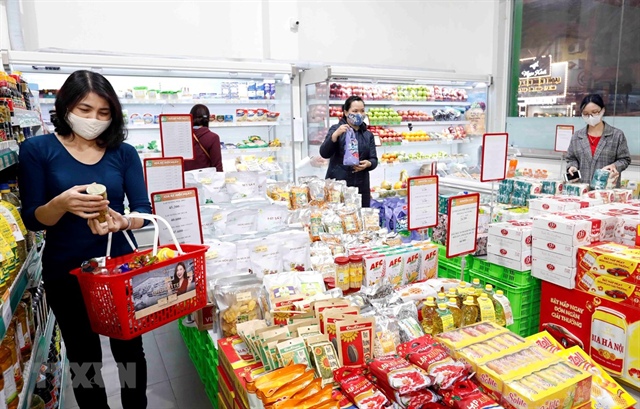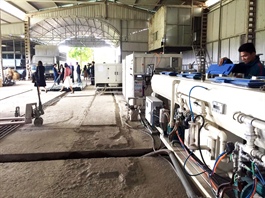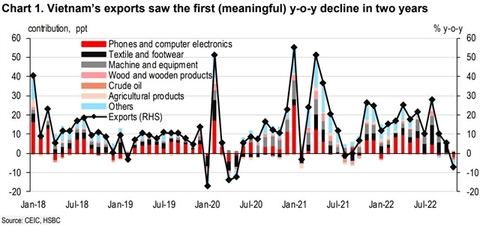Exporters developing products for domestic market
Exporters developing products for domestic market
Consumers across the globe have tightened spending which has led to export orders being cancelled in Vietnam, even for the coming Christmas and New Year season.
Illustrative photo. |
With orders plummeting export businesses are now finding it extremely difficult to maintain production or retain their work force. Rising inflation and the ongoing Russia-Ukraine conflict is taking a serious toll on the global economy. Businesses that once only focused on exports may now have to find ways to convert their products for sale in the domestic market, although this market may not be that viable or lucrative.
Vying for domestic market
The wood industry is one of the first export businesses to be affected by plummeting orders after two major markets of Vietnam, the US and the European Union, cancelled orders for the coming festive season. Although the first six months of the year were packed with a substantial amount of orders, after July orders began to dwindle sharply and even cancelled without any notice. These sudden cancellations of orders put export businesses in a tight spot as it became difficult to maintain production and pay back bank interest. The only choice left for these businesses is to find alternate outlets at this time.
At a meeting of the Ho Chi Minh City Fine Arts and Woodworking Association at the end of August, Mr. Nguyễn Văn Sang, Director of Vietnam Import-Export Joint Stock Company (VietProducts), said that the domestic market is the only hope for enterprises at the moment. The company is now aggressively rebranding for the local market. Their advantage in the domestic market is that their products are already having a fair share of recognition in large furniture supermarkets in some locations in Thu Duc City.
Besides the wood industry, the other two major export businesses that have been affected most severely are the textiles and garments industries and the leather and footwear export businesses. These two export industries have seen cancelled orders due to global tightening of consumer spending. In such circumstances it has been difficult to retain workers or continue production.
However, some businesses are still struggling to maintain production and retain their workers by finding buyers in markets that were previously not given much attention such as Australia and Canada. This is no time for businesses to snub any orders, however small they may be. Along with search for new markets, a few businesses have also connected with each other to produce specific goods for the domestic market.
Mr. Thân Đức Việt, General Director of Garment 10 Corporation JSC (Garco 10), said that in the last 30 years, his company has continuously launched many fashion brands for office going people in the domestic market such as Garco10 Expert, Garco10 Classic, Eternity GrusZ, and Cleopatra. Now at this time when exports are being so severely affected, Garco 10 has expanded to more stores, fashion centers, and is working with more than 200 agents nationwide, besides also promoting online sales to maximize in the domestic market.
Domestic market potential
Some of the factors when talking about the domestic market are a potential market with nearly 100 million people, a growing middle class, huge purchasing power, and consumers spending more and more aggressively. This is probably also the reason why export businesses are looking at developing products for the domestic market.
In a talk with Saigon Investment, Mr. Phạm Xuân Hồng, Chairman of the Ho Chi Minh City Textile and Apparel Association, said that 100 million people makes for a strong potential market, but the actual consumption compared to exports is still very modest. Even though businesses push hard to sell in the domestic market, they will be able to offset only a very small part of their difficulties, such as helping workers to retain their jobs. In the current scenario, Vietnamese people are also starting to tighten their spending due to rising inflation, so the purchasing power of non-essential goods such as furniture, clothing, and footwear is clearly not so strong.
Looking at businesses that are aggressively rebuilding the domestic market, it shows that most of them have already been dealing in both the domestic and export sectors before, but if they hope to return as strongly in the domestic market alone, then this may not be possible.
The main reason is that the goods made for exports are designed differently to those in the domestic market. It is also not possible for them to use the same materials or apply the same quality standards. This fact will cause difficulties in production, which then means that almost all these businesses will have to invest in new research, design, brand, and understand the consumer habits, while also having to invest in more local chain stores.
However, despite heavy promotional campaigns, all goods put on the market may not sell immediately. For instance, Garco 10 had to prepare for two years to launch the Generos men fashion brand. Exports may not be difficult but moving into the domestic market and becoming a domestic brand will certainly be very challenging.
With many businesses now vying for the domestic retail market, competition has become fierce. For instance, textiles and garments available in the markets are from all kinds of domestic and foreign brands, and from all segments of high-end to mid-range to the very cheap. Even though many domestic brands have been around for a long time, they all are facing fierce competition from foreign products entering the home market.
In recent years, there have been some very strong export textile and garment enterprises that have been working towards the development of their products in the domestic market. These companies have invested a lot in brand promotion through many programs, including sponsorship of beauty contests. However, the scale of this development so far has been very modest as compared to what is required in the present crisis.
Nonetheless, although every export business at this time is looking at all forms of outlets for their goods in the domestic market as one way to sustain their businesses, every export company will have to work towards its own orientation and suitability to survive. In the present situation it also looks like the Government may have to step in to support this crucial industry at an excruciatingly difficult time.

























